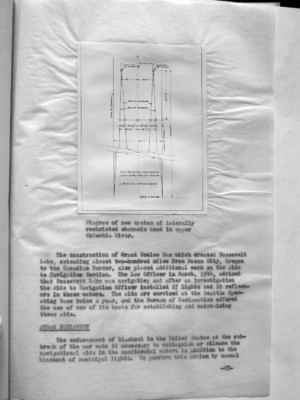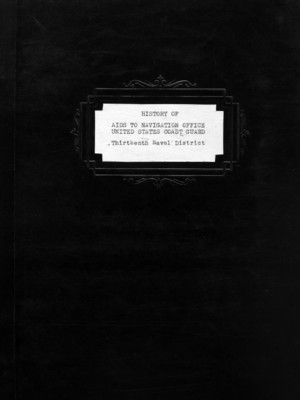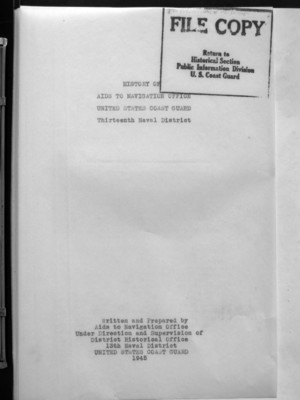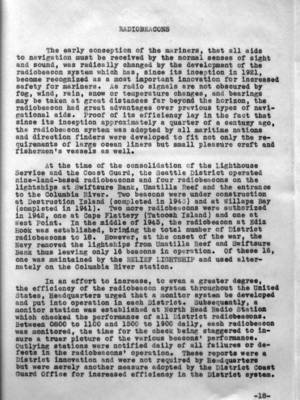Pages That Mention United States
Coast Guard District narrative histories 1945
10
(image)
Diagram of new system of laterally restricted channels used in upper Columbia River.
The construction of Grand Coulee Dam which created Roosevelt Lake, extending almost two-hundred miles from Mason City, Oregon to the Canadian Border, also placed additional work on the Aide to Navigation Section. The Law Officer in March, 1944, advised that Roosevelt Lake was navigable; and after an investigation the Aids to Navigation Officer installed 27 lights and 10 reflectors in those waters. The aids are serviced at the Seattle Operating Base twice a year, and the Bureau of Reclamation offered the use of one of its boats for establishing and maintaining these aids.
ANRAC ??? EQUIPMENT
The enforcement of blackout in the United States at the outbreak of the war made it necessary to extinguish or silence the navigational aids in the continental waters in addition to the blackout of municipal lights. To perform this action by manual
-27-
15
FILE COPY
Return to Historical Section Public Information Division U.S. Coast Guard
HISTORY OF AIDS TO NAVIGATION OFFICE UNITED STATES COAST GUARD Thirteenth Naval District
Written and Prepared by Aids to Navigation Office Under Direction and Supervision of District Historical Office 13th Naval District UNITED STATES COAST GUARD 1945
16
FOREWORD
A history of Aids to Navigation is, prior to 1939, a history of the Lighthouse Service. Since 1789, the Lighthouse Service had established and maintained navigational aids along all coasts of the United States and all its inland waters. In 1939, the Reorganization Plan II provided for the consolidation of the Bureau of Lighthouses with the Coast Guard. The transfer of the duties from the Bureau to the Coast Guard were made mainly to reduce expenditures to the fullest extent for the efficient operation of the Government. It was appreciated and understood that there was a natural reluctance of personnel to change from the Bureau to another Service. To overcome this hesitation, the transfer was effected by avoiding discharges wherever possible and "cutting" the personnel by not filling vacancies which were in effect at the time of the transfer.
The Secretary of the Treasury authorized the induction of officers and crew of tenders and Lightships, Keepers of Lighthouses and Depots, Light Attendants, Radio Electricians, Examiners and Maintenance Supervisors, as the duties of those positions were comparable with duties performed in the military service of the Coast Guard. In addition to those positions, there was a large group of positions which were analogous to those now held by civilian employees of the Coast Guard, such as draftsmen, mechanics, laborers, watchmen, messengers in the sub-professional and custodial duties and various positions in the clerical, administrative and physical service. This group continued exactly as before and received promotions and increase in
37
The early conception of the mariners, that all aids to navigation must be received by the normal senses of sight and sound, was radically changed by the development of the radiobeacon system which has, since its inception in 1921, become recognized as a most important innovation for increased safety for mariners. As radio signals are not obscured by fog, wind, rain, snow or temperature changes, and bearings may be taken at great distances far beyond the horizon, the radiobeacon had great advantages over previous types of navigational aids. Proof of its efficiency lay in the fact that since its inception approximately a quarter of a century ago, the radiobeacon system was adopted by all maritime nations and direction finders were developed to fit not only the requirements of large ocean liners, but small pleasure craft and fisherman's vessels as well.
At the time of the consolidation of the Lighthouse Service and the Coast Guard, the Seattle District operated nine-land-based radiobeacons and four radiobeacons on the lightships at Swiftsure Bank, Umatilla Reef and the entrance to the Columbia River. Two beacons were under construction at Destruction Island (completed in 1943) and at Willapa Bay (completed in 1941). Two more radiobeacons were authorized in 1842, one at Cape Flattery (Tatoosh Island) and one at West Point. In the middle of 1945, the radiobeacon at Ediz Hook was established, bringing the total number of District radiobeacons to 18. However, at the onset of the war, the Navy removed the lightships from Umatilla Reef and Swiftsure Bank thus leaving only 16 beacons in operation. Of these 16, one was maintained by the RELIEF LIGHTSHIP and used alternately on the Columbia River station.
In an effort to increase, to even a greater degree, the efficiency of the radiobeacon system throughout the United States, headquarters urged that a monitor system be developed and put into operation in each District. Subsequently, a monitor station was established at North head Radio Station which checked the performance of all District radiobeacons. Between 0800 to 1100 and 1500 to 1900 daily, each radiobeacon was monitored, the time for the check being staggered to insure a truer picture of the various beacons' performance. Outlying stations were notified daily of all failures or defects in the radiobeacons' operation. These reports were a District innovation and were not required by Headquarters but were merely another measure adopted by the District Coast Guard Office for increased efficiency in the District system.
-18-




